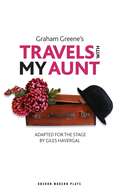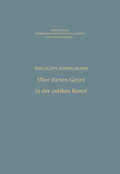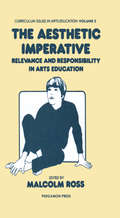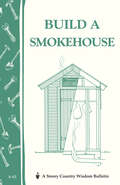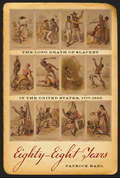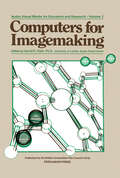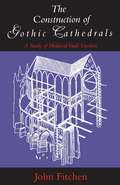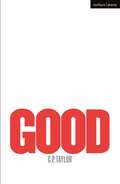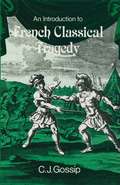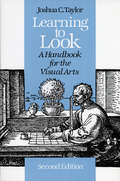- Table View
- List View
Travels with My Aunt: A Novel (The\collected Edition Ser. #Vol. 20)
by Graham Greene Giles HavergalStage version of the popular novel, first performed at the Citizens Theatre, Glasgow before two West End productions and one on Broadway, winning an Olivier award on the way.
Über Hirten-Genre in der antiken Kunst (Abhandlungen der Rheinisch-Westfälischen Akademie der Wissenschaften #65)
by Nikolaus HimmelmannThe Aesthetic Imperative: Relevance and Responsibility in Arts Education
by Malcolm RossThe Aesthetic Imperative: Relevance and Responsibility in Arts Education is a collection of papers that covers various concerns in assessment in the context of arts education. In the first chapters, the text examines the predicament of the arts. The next two chapters relate assessment in the context of esthetic education and evaluation in the arts. Chapter 4 talks about the assessment of esthetic developments in the visual mode. The fifth chapter details the importance of evaluating the quality of the test itself, while the sixth chapter covers the conflict between schools and art education. In Chapter 7, the book talks about treating English as an art. The eighth chapter discusses the relevance of art in education, while the ninth chapter provides a conclusive discussion on art education. The text will be of great interest to readers who are concerned with the status of art as part of a school curriculum.
The Architectural History of Canterbury Cathedral (Routledge Revivals)
by Francis WoodmanFirst Published in 1981 The Architectural History of Canterbury Cathedral traces the entire architectural history of the church from Anglo-Saxon times to the present day. Every major epoch of English architecture is represented, from the Norman Conquest to the splendours of the Tudor age. One of the main concerns has been a reconstruction of the two Norman phases – Lanfranc’s cathedral from 1070 and the great choir of St Anselm begun in 1096. Dr Woodman puts forward new and provocative ideas about the architecture of William of Sens and his original proposals for the new Gothic choir and Trinity Chapel. The Perpendicular phases are detailed for the first time, including an important reattribution and redating of the splendid pulpitum. It analyses for the first time the precise areas of building completed by individual master masons, and he discusses details revealed by archaeological excavations and restoration work that are no longer visible. This stimulating study is a must read for scholars and researchers of British architecture, architectural history and architecture in general.
The Architectural History of Canterbury Cathedral (Routledge Revivals)
by Francis WoodmanFirst Published in 1981 The Architectural History of Canterbury Cathedral traces the entire architectural history of the church from Anglo-Saxon times to the present day. Every major epoch of English architecture is represented, from the Norman Conquest to the splendours of the Tudor age. One of the main concerns has been a reconstruction of the two Norman phases – Lanfranc’s cathedral from 1070 and the great choir of St Anselm begun in 1096. Dr Woodman puts forward new and provocative ideas about the architecture of William of Sens and his original proposals for the new Gothic choir and Trinity Chapel. The Perpendicular phases are detailed for the first time, including an important reattribution and redating of the splendid pulpitum. It analyses for the first time the precise areas of building completed by individual master masons, and he discusses details revealed by archaeological excavations and restoration work that are no longer visible. This stimulating study is a must read for scholars and researchers of British architecture, architectural history and architecture in general.
Build a Smokehouse: Storey Country Wisdom Bulletin A-81 (Storey Country Wisdom Bulletin)
by Ed EpsteinSince 1973, Storey's Country Wisdom Bulletins have offered practical, hands-on instructions designed to help readers master dozens of country living skills quickly and easily. There are now more than 170 titles in this series, and their remarkable popularity reflects the common desire of country and city dwellers alike to cultivate personal independence in everyday life.
Built: The Hidden Stories Behind Our Structures (Bloomsbury Revelations Ser.)
by Roma AgrawalImagine you woke up one morning to find everything created by engineers had disappeared. What would you see?No cars, no houses; no phones, bridges or roads. No tunnels under tidal rivers, no soaring skyscrapers. The impact that engineering has had on the human experience is undeniable, but it is also often invisible.In BUILT, structural engineer Roma Agrawal takes a unique look at how construction has evolved from the mud huts of our ancestors to skyscrapers of steel that reach hundreds of metres into the sky. She unearths how engineers have tunnelled through kilometres of solid mountains; how they've bridged across the widest and deepest of rivers, and tamed Nature's precious – and elusive – water resources. She tells vivid tales of the visionaries who created the groundbreaking materials in the Pantheon's record-holding concrete dome and the frame of the record-breaking Eiffel Tower. Through the lens of an engineer, Roma examines tragedies like the collapse of the Quebec Bridge, highlighting the precarious task of ensuring people's safety they hold at every step. With colourful stories of her life-long fascination with buildings – and her own hand-drawn illustrations – Roma reveals the extraordinary secret lives of structures.
Computers for Imagemaking
by D. ClarkComputers for Image-Making tells the computer non-expert all he needs to know about Computer Animation. In the hands of expert computer engineers, computer picture-drawing systems have, since the earliest days of computing, produced interesting and useful images. As a result of major technological developments since then, it no longer requires the expert's skill to draw pictures; anyone can do it, provided they know how to use the appropriate machinery. This collection of specially commissioned articles reflects the diversity of user applications in this expanding field
The Construction of Gothic Cathedrals: A Study of Medieval Vault Erection
by John FitchenJohn Fitchen systematically treats the process of erecting the great edifices of the Gothic era. He explains the building equipment and falsework needed, the actual operations undertaken, and the sequence of these operations as specifically as they can be deduced today. Since there are no contemporary accounts of the techniques used by medieval builders, Fitchen's study brilliantly pieces together clues from manuscript illuminations, from pictorial representations, and from the fabrics of the building themselves. "Anyone who has caught the fascination of Gothic Churches (and once caught, has almost necessarily got it in the blood) will find this book enthralling. . . . Clearly written and beautifully illustrated." —A. D. R. Caroe, Annual Review, Central Council for the Care of Churches "Fitchen's study is a tribute to the extraordinary creative and engineering skills of successive generations of mediaeval builders. . . . This study enables us to appreciate more fully the technical expertise and improvements which enabled the creative spirit of the day to find such splendid embodiment." —James Lingwood, Oxford Art Journal "Fitchen, in what can only be defined as an architectural detective story, fully explores the problems confronting the medieval vault erectors and uncovers their solution. . . . This is a book that no serious student of architecture will want to miss." —Progressive Architecture
Dictionary Of Modern Art
by Matthew BaigellAlphabetically arranged and crossreferenced entries provide background information on major American painters, sculptors, printmakers, and photographers, plus important topics and movements central to American art from the sixteenth century to the present.
Dictionary Of Modern Art
by Matthew BaigellAlphabetically arranged and crossreferenced entries provide background information on major American painters, sculptors, printmakers, and photographers, plus important topics and movements central to American art from the sixteenth century to the present.
Fernsehen und Demokratie: Eine Inhaltsanalyse der Fernsehnachrichtensendungen von ARD und ZDF vom Frühjahr 1977 (Forschungsberichte des Landes Nordrhein-Westfalen #3006)
by Heribert SchatzGood (Modern Plays)
by C. P. TaylorProfessor John Halder is a 'good' man. But 'good' men must adapt to survive.As the world faces its Second World War, Halder finds himself pulled into a movement with unthinkable consequences.Good is a story about a liberal-minded university professor who drifts well-meaningly into a position in the upper reaches of the Nazi administration. John Halder, a professor of literature, seems to be a good man; he diligently visits his blind and senile mother and looks after his vacant wife and three children. He is unremarkable, other than an unusual neurotic tic: the imaginary sound of band music plays in the background of his life, particularly at moments of high emotion. But by writing a book – the result of his own experience – discussing euthanasia for senile elderly people and by lecturing on the delicacy of German literary culture, John has unintentionally made himself a very desirable acquisition for the Nazi party.A profound and alarming examination of passivity and the rationalisation of evil.Originally published in 1982, this new edition was published to coincide with the West End revival in 2022 starring David Tennant.
Image Sequence Analysis (Springer Series in Information Sciences #5)
by T. S. HuangThe processing of image sequences has a broad spectrum of important applica tions including target tracking, robot navigation, bandwidth compression of TV conferencing video signals, studying the motion of biological cells using microcinematography, cloud tracking, and highway traffic monitoring. Image sequence processing involves a large amount of data. However, because of the progress in computer, LSI, and VLSI technologies, we have now reached a stage when many useful processing tasks can be done in a reasonable amount of time. As a result, research and development activities in image sequence analysis have recently been growing at a rapid pace. An IEEE Computer Society Workshop on Computer Analysis of Time-Varying Imagery was held in Philadelphia, April 5-6, 1979. A related special issue of the IEEE Transactions on Pattern Anal ysis and Machine Intelligence was published in November 1980. The IEEE Com puter magazine has also published a special issue on the subject in 1981. The purpose of this book is to survey the field of image sequence analysis and to discuss in depth a number of important selected topics. The seven chap ters fall into two categories. Chapters 2, 3, and 7 are comprehensive surveys on, respectively, the whole field of image sequence analysis, efficient coding of image sequences, and the processing of medical image sequences. In Chapters 1, 4, 5, and 6 the authors present mainly results of their own research on, respectively, motion estimation, noise reduction in image sequences, moving object extraction, and occlusion.
IMPRO Improvisation and the Theatre: Improvisation And The Theatre (Bloomsbury Revelations Ser.)
by Keith JohnstoneA leading figure in the theatre, Keith Johnstone lays bare his techniques and exercises to foster spontaneity and narrative skill for actors. These techniques and exercises were evolved in the actors' studio, when he was Associate Director of the Royal Court and then in demonstrations to schools and colleges and ultimately in the founding of a company of performers called The Theatre Machine. Divided into four sections, "Status", "Spontaneity", "Narrative Skills" and "Masks and Trance", arranged more or less in the order a group might approach them, the book sets out the specific approaches which Johnstone has himself found most useful and most stimulating. The result is a fascinating exploration of the nature of spontaneous creativity. "If teachers were honoured in the British theatre along-side directors, designers and playwrights, Keith Johnstone would be as familiar a name as are those of . . . Jocelyn Herbert, Edward Bond and other young talents who were drawn to the great lodestone of the Royal Court Theatre in the late 1950s. As head of the script department, Johnstone played a crucial part in the development of the 'writers' theatre . . . " Irving Wardle
In a Glamourous Fashion: The Fabulous Years of Hollywood Costume Design (Routledge Revivals)
by W. Robert LaVineFirst published in 1981, In A Glamourous Fashion is not only a fascinating look at film fashion portraying the glamour and glitter of Hollywood’s heyday; but is also an invaluable reference source for any student of the film, of costume, or of the social history. It documents some of the best work of the designers – names like Adrian, Cecil Beaton, Edith Head – but tells the often-dramatic story of their careers and their relationships with legendary stars such as Garbo, Dietrich, Monroe and many more. Here are the stories behind the screen’s most famous costumes: Walter Plunkett’s ‘curtain dress’ for Scarlett O’Hara; the red Jezebel gown Orry-Kelly designed for Bette Davis; the slinky back satin sheath Rita Hayworth wore in Gilda; and the extravagant gown – ₤ 15, 000 worth of mink – worn by Ginger Rogers in Lady in the Dark. The photographs and original sketches are an essential and decorative complement to the text; there is an index, bibliography, and a full list of Academy Award winners for costume design.
In a Glamourous Fashion: The Fabulous Years of Hollywood Costume Design (Routledge Revivals)
by W. Robert LaVineFirst published in 1981, In A Glamourous Fashion is not only a fascinating look at film fashion portraying the glamour and glitter of Hollywood’s heyday; but is also an invaluable reference source for any student of the film, of costume, or of the social history. It documents some of the best work of the designers – names like Adrian, Cecil Beaton, Edith Head – but tells the often-dramatic story of their careers and their relationships with legendary stars such as Garbo, Dietrich, Monroe and many more. Here are the stories behind the screen’s most famous costumes: Walter Plunkett’s ‘curtain dress’ for Scarlett O’Hara; the red Jezebel gown Orry-Kelly designed for Bette Davis; the slinky back satin sheath Rita Hayworth wore in Gilda; and the extravagant gown – ₤ 15, 000 worth of mink – worn by Ginger Rogers in Lady in the Dark. The photographs and original sketches are an essential and decorative complement to the text; there is an index, bibliography, and a full list of Academy Award winners for costume design.
Learning to Look: A Handbook for the Visual Arts
by Joshua C. TaylorSometimes seeing is more difficult for the student of art than believing. Taylor, in a book that has sold more than 300,000 copies since its original publication in 1957, has helped two generations of art students "learn to look." This handy guide to the visual arts is designed to provide a comprehensive view of art, moving from the analytic study of specific works to a consideration of broad principles and technical matters. Forty-four carefully selected illustrations afford an excellent sampling of the wide range of experience awaiting the explorer. The second edition of Learning to Look includes a new chapter on twentieth-century art. Taylor's thoughtful discussion of pure forms and our responses to them gives the reader a few useful starting points for looking at art that does not reproduce nature and for understanding the distance between contemporary figurative art and reality.
Learning to Look: A Handbook for the Visual Arts
by Joshua C. TaylorSometimes seeing is more difficult for the student of art than believing. Taylor, in a book that has sold more than 300,000 copies since its original publication in 1957, has helped two generations of art students "learn to look." This handy guide to the visual arts is designed to provide a comprehensive view of art, moving from the analytic study of specific works to a consideration of broad principles and technical matters. Forty-four carefully selected illustrations afford an excellent sampling of the wide range of experience awaiting the explorer. The second edition of Learning to Look includes a new chapter on twentieth-century art. Taylor's thoughtful discussion of pure forms and our responses to them gives the reader a few useful starting points for looking at art that does not reproduce nature and for understanding the distance between contemporary figurative art and reality.
Learning to Look: A Handbook for the Visual Arts
by Joshua C. TaylorSometimes seeing is more difficult for the student of art than believing. Taylor, in a book that has sold more than 300,000 copies since its original publication in 1957, has helped two generations of art students "learn to look." This handy guide to the visual arts is designed to provide a comprehensive view of art, moving from the analytic study of specific works to a consideration of broad principles and technical matters. Forty-four carefully selected illustrations afford an excellent sampling of the wide range of experience awaiting the explorer. The second edition of Learning to Look includes a new chapter on twentieth-century art. Taylor's thoughtful discussion of pure forms and our responses to them gives the reader a few useful starting points for looking at art that does not reproduce nature and for understanding the distance between contemporary figurative art and reality.
Learning to Look: A Handbook for the Visual Arts
by Joshua C. TaylorSometimes seeing is more difficult for the student of art than believing. Taylor, in a book that has sold more than 300,000 copies since its original publication in 1957, has helped two generations of art students "learn to look." This handy guide to the visual arts is designed to provide a comprehensive view of art, moving from the analytic study of specific works to a consideration of broad principles and technical matters. Forty-four carefully selected illustrations afford an excellent sampling of the wide range of experience awaiting the explorer. The second edition of Learning to Look includes a new chapter on twentieth-century art. Taylor's thoughtful discussion of pure forms and our responses to them gives the reader a few useful starting points for looking at art that does not reproduce nature and for understanding the distance between contemporary figurative art and reality.
